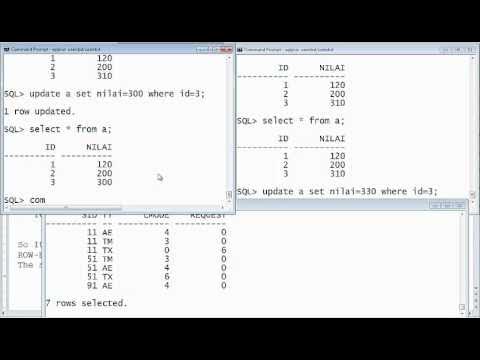Everything you need to know about Read Uncommitted Isolation Level
Summary
TLDRThis video delves into the 'Read Uncommitted' isolation level in databases, explaining when and why it is used. It begins with a brief introduction to isolation levels in the context of ACID properties and highlights how 'Read Uncommitted' allows transactions to read uncommitted changes from other transactions, potentially causing issues like dirty reads, phantom reads, and non-repeatable reads. The video emphasizes that while this isolation level can increase throughput, it sacrifices data correctness, making it rarely suitable for production environments. However, it may be useful for specific read-only scenarios where accuracy isn't crucial.
Takeaways
- 🔍 Isolation level is the 'I' in ACID, controlling how much of a transaction's changes are visible to other transactions running in parallel.
- 📊 Read Uncommitted isolation level allows a transaction (T2) to read data modified by another transaction (T1) before T1 commits, leading to potential issues.
- ⚠️ Read Uncommitted can result in 'dirty reads,' where T2 reads uncommitted changes from T1, and T1 might roll back, making T2's data incorrect.
- 👻 'Phantom reads' occur in Read Uncommitted when T2 reads rows added by T1 before T1 commits, and T1 later aborts, causing T2 to process non-existent data.
- 🔄 'Non-repeatable reads' happen in Read Uncommitted, where T2 reads the same data multiple times but gets different values due to uncommitted changes by T1.
- 🚫 Due to dirty reads, phantom reads, and non-repeatable reads, Read Uncommitted is rarely used in production systems.
- 🔒 The advantage of Read Uncommitted is its non-locking nature, which may result in slightly higher throughput due to no locking overhead.
- 📊 Situations where Read Uncommitted might be used include cases where accuracy isn't critical, such as getting the count of likes on a post.
- 🚀 Read Uncommitted might provide minor performance gains, but these are generally not significant enough to justify the risks in most production scenarios.
- 💡 It's important to understand the database isolation level configured, as changing the use case (e.g., introducing writes) may require a different isolation level to ensure data consistency.
Q & A
What is the role of isolation in ACID properties?
-Isolation ensures that the intermediate state of a transaction is not visible to other transactions. It defines how much of a transaction's changes are visible to other transactions running in parallel, helping maintain data integrity.
What does the 'read uncommitted' isolation level allow in a database?
-The 'read uncommitted' isolation level allows a transaction to read uncommitted changes made by another transaction. This can result in dirty reads, where a transaction reads data that may later be rolled back.
What are the three major issues with the 'read uncommitted' isolation level?
-The three main problems are dirty reads, phantom reads, and non-repeatable reads. These issues can cause inconsistency in the data a transaction reads while other transactions are modifying it.
Can you explain what a 'dirty read' is?
-A dirty read occurs when a transaction reads data that has been modified by another transaction but not yet committed. If the modifying transaction is rolled back, the data read is invalid.
What is a 'phantom read' in the context of database transactions?
-A phantom read happens when a transaction reads data that was not present when the transaction started but was added by another transaction that has not yet committed. If the other transaction is rolled back, the read data is invalid.
How does the 'non-repeatable read' issue manifest?
-A non-repeatable read occurs when a transaction reads the same row multiple times and gets different results. This happens because another transaction modifies the data between the reads, but the changes are not yet committed.
Why is 'read uncommitted' generally not used in production environments?
-'Read uncommitted' is rarely used in production because it compromises data integrity by allowing dirty reads, phantom reads, and non-repeatable reads. Most production systems prioritize correctness over the slight performance gain from avoiding locking.
When would the 'read uncommitted' isolation level be appropriate?
-It can be appropriate when correctness is not critical, such as when reading statistics like a count of likes on a post. In these cases, reading uncommitted values would not significantly impact the system, and locking isn't necessary.
What performance benefits does the 'read uncommitted' isolation level offer?
-The main performance benefit is non-locking reads, which can increase throughput slightly by avoiding locks when reading data. However, the performance improvement is typically minimal compared to other isolation levels.
How should a database administrator approach a system that uses 'read uncommitted' isolation?
-A database administrator should carefully evaluate why 'read uncommitted' was set. If the system’s use case involves reading and writing data based on these reads, it may lead to data inconsistency, and the isolation level should be reconsidered.
Outlines

This section is available to paid users only. Please upgrade to access this part.
Upgrade NowMindmap

This section is available to paid users only. Please upgrade to access this part.
Upgrade NowKeywords

This section is available to paid users only. Please upgrade to access this part.
Upgrade NowHighlights

This section is available to paid users only. Please upgrade to access this part.
Upgrade NowTranscripts

This section is available to paid users only. Please upgrade to access this part.
Upgrade NowBrowse More Related Video
5.0 / 5 (0 votes)





